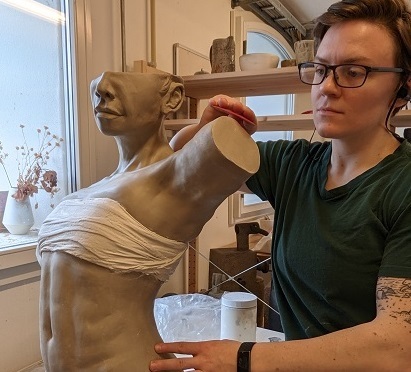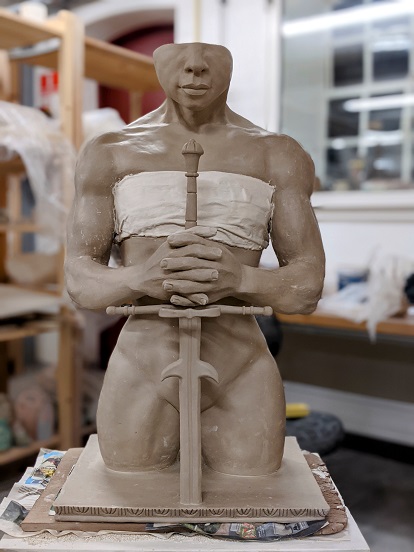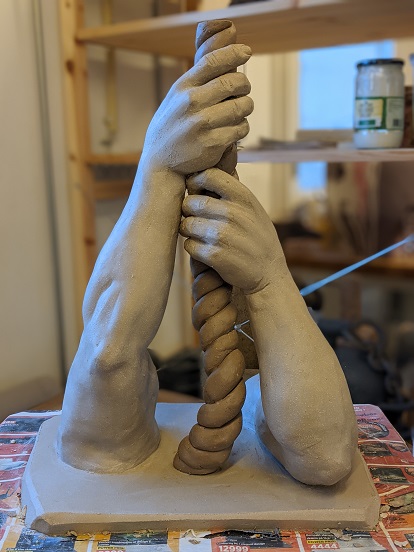
CJ Carter Reflects on International Artist Residency
Experiencing a change in scenery, even just a short break from regular routines and responsibilities, can inspire new ideas, perspectives, and motivation. Ceramics Instructor CJ Carter made just such a leap, taking a position as the Young Artist-in-Residence at Guldagergaard - International Ceramic Research Center in Denmark. As this summer residency is coming to a close, we checked in with CJ to find out more about this transformative experience and how it will inform their teaching.
How did you come to be a Young Artist-in-Residence at the Guldagergaard - International Ceramics Research Center?
For years, I have wanted to get an MFA in ceramics so that I could pursue teaching in higher education. I knew artist residencies would greatly strengthen my application, especially since my BFA is in 3D Digital Graphics instead of ceramics. So, in 2019 I decided I was finally ready and quit my corporate job and focus on developing my portfolio. I thought a wide breadth of life and cultural experiences were key to creating engaging art, so I set my sights on international residencies. Google took it from there.
What do you do as a Young Artist-In-Residence? What's a typical day like?
What separates the Young Artist-In-Residence (YAIR) program from the Artist-In-Residence (AIR) program here at Guldagergaard is the work-exchange aspect. If you're an AIR, you pay for room and studio space. As a YAIR, I work 20 hours a week for Guldagergaard in exchange for room and studio space (I also get a small stipend for materials every month). Within the center, we are considered assistants to the studio technicians which means we do typical tech work: reclaiming clay, mixing glazes, loading/unloading and firing kilns, cleaning sink traps (which is very gross), schlepping waste, stacking wood, etc.
Currently, however, Guldagergaard is preparing for an outdoor summer festival. As such, we have been tasked with creating Guldagergaard-branded work for fundraisers or activities. For example, during my first week I finished sanding the last 300 of the 1500 slip-cast porcelain cups that will be decorated by kids who attend the festival. For the past several weeks, another assistant and I have been throwing 500 cups that will be sold at the coffee stand. Someone else is throwing huge vases, and another is making plates.
I'd imagine the weekly life of my predecessors was very different in pre-pandemic times. As it is, Denmark is shut down and visiting the rest of Europe is impossible. So as such, my weekday and weekend don't vary much. Monday through Friday I get up at 7:00 a.m., exercise, have a meeting with the staff at 9:00 a.m., then work my four-hour shift until 1:00 p.m. At that point, usually I have lunch then get to work on my own projects until the 7:00 p.m. dinner bell (artists take turns providing a communal dinner for everyone living at Guldagergaard every night). Then I'm back to work until bedtime, usually around 11:00 p.m. The weekend varies only in that I don't have to volunteer for four hours and I let myself sleep in.

Why did you think it a good fit for your artistic development at this point? What has been your focus while you've been there?
I had two major artistic goals coming here. First, I wanted to figure out what kind of glaze treatment I was going to use to finish my work. I have always been dissatisfied with how my pieces look in the end, and I wanted to change that. Second, I wanted to go big. I have a small personal studio with a medium-sized kiln, but this gave me the opportunity to create sculptures up to 31 inches tall and have the space to spread out as I was creating.
To anyone considering an artist residency, I would heartily recommend the experience. Keep in mind no one is there to hold your hand; you have to be self-sufficient and self-motivated. I would also recommend sticking to whatever project you intend for the time spent at the residency, but allow yourself to flex when things don't work the way you expect. What's more, make sure you step away from your work to talk to the artists around you - they are your greatest resource.
What do you hope to gain from your experience there?
Besides the technical development, networking was a huge motivator for me. I thrive in a creative atmosphere, especially when I'm surrounded by other working artists with styles drastically different from my own. I love hearing other's stories and am easily inspired by their artistic journeys. In short, I hoped to gain more clay friends.
What has your experience been like to this point? Highlights?
A big highlight is how validating this experience has been. To be honest, I have historically struggled with a degree of imposter syndrome within the art world because Seattle is filled with so many talented ceramicists. I had spent so much time going to demos, lectures, workshops, and conventions over the years, I assumed that because I was still constantly learning, that I didn't know anything.
This is patently untrue.
Being here has bolstered my belief in my own ability and experience. I have learned things here, yes, but I see that every piece of information I've gained has built upon the last, forming a vast network of knowledge. I hadn't believed that I could "make it" as a sculpture artist prior to my time at Guldagergaard, but on the eve of my departure I look forward to focusing on sculpture when I return home.
 Have there been any aspects of your experience that have surprised you? How about challenges?
Have there been any aspects of your experience that have surprised you? How about challenges?
Simply put, my work has surprised me. For the past two years I have focused on teaching and throwing pottery, only sculpting for class demonstrations. When I set myself to developing a body of work, I found that the time I spent resting was not wasted; my skills had vastly improved likely because of my time spent observing. Then add weeks of time I could spend on nothing other than creating, and my skills surged from piece to piece - I grew with each piece I made.
This experience did not come without challenges, however. The most predictable was the homesickness which hit me pretty hard after about a month. However, Denmark is only about 9 hours ahead of Seattle, so I was still able to call my partner nearly every night for the typical Zoom chat most of us have become accustomed to.
As for technical challenges, I was prepared to learn new kiln controls and make the mental leap from Fahrenheit to Celsius, but what I didn't anticipate was the availability of glaze materials. All of the frits and feldspars I was familiar with are mined in North America and thus not available in Europe. Each component is comprised of many different elements in varying quantities, so there was no way to simply substitute one-for-one. I had to call on my studio mate to help me reformulate the glazes I was testing.
What's more, with pushing myself to an unfamiliar scale with finishes I hadn't used before, I found myself with some obstacles. After firing my first piece, I found the rock the mermaid sat upon - the base of the sculpture - had completely disintegrated. I have my suspicions as to why this happened, but I was left with either scrapping weeks of work or trying to fix it.
Thankfully, the studio manager here has a degree in art restoration, so she set me up with some resin and pigments and I got to work. Sculpture repair is a very important skill, and I'm very thankful to have dipped my toe in that arena. (You'll be happy to know my mermaid looks completely undamaged.)
What from this experience do you think you’ll bring into your teaching?
It's hard to say what wouldn't be applicable. With every artist I see working, I absorb techniques, ideas, and experiences that I can use to help guide the interests of students. I am a figurative sculptor, but I am quite confident I would be able to advise a student on how to create massive, boulder-like monoliths because I observed an artist from Berlin creating them alongside me. Or teach a student the traditional technique of Mishima because an artist on my other side used it on her delicate porcelain pagodas.
What's more, I've seen how people do things differently here. It is so beneficial to take yourself out of your familiar habitat to see that there are other ways to accomplish something and this new way may be better. If you are open to it, you can learn things every day from the most unlikely of sources.
Is there anything else you’d like to share about your time there, your art, or yourself?
This experience gave me the confidence to push my art in a direction I didn't have the bravery to pursue. I am exploring non-binary gender and expression after years of thinking people wouldn't understand or be interested. I realized that I had a voice worth hearing and an audience whom I did not realize was waiting for me.
Learn more about CJ Carter and their class, Ceramic Sculpture: More Techniques.